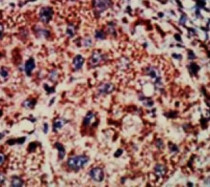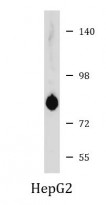ARG42147
anti-PFKL antibody
anti-PFKL antibody for IHC-Formalin-fixed paraffin-embedded sections,Western blot and Human
Overview
| Product Description | Rabbit Polyclonal antibody recognizes PFKL |
|---|---|
| Tested Reactivity | Hu |
| Tested Application | IHC-P, WB |
| Host | Rabbit |
| Clonality | Polyclonal |
| Isotype | IgG |
| Target Name | PFKL |
| Antigen Species | Human |
| Immunogen | KLH-conjugated synthetic peptide between aa. 669-699 of Human PFKL. |
| Conjugation | Un-conjugated |
| Alternate Names | PFK-B; 6-phosphofructokinase type B; EC 2.7.1.11; ATP-dependent 6-phosphofructokinase, liver type; PFK-L; Phosphofructo-1-kinase isozyme B; ATP-PFK; Phosphohexokinase |
Application Instructions
| Application Suggestion |
|
||||||
|---|---|---|---|---|---|---|---|
| Application Note | * The dilutions indicate recommended starting dilutions and the optimal dilutions or concentrations should be determined by the scientist. | ||||||
| Positive Control | HepG2 | ||||||
| Observed Size | ~ 85 kDa |
Properties
| Form | Liquid |
|---|---|
| Purification | Purified |
| Buffer | PBS and 0.09% (W/V) Sodium azide. |
| Preservative | 0.09% (W/V) Sodium azide. |
| Storage Instruction | For continuous use, store undiluted antibody at 2-8°C for up to a week. For long-term storage, aliquot and store at -20°C or below. Storage in frost free freezers is not recommended. Avoid repeated freeze/thaw cycles. Suggest spin the vial prior to opening. The antibody solution should be gently mixed before use. |
| Note | For laboratory research only, not for drug, diagnostic or other use. |
Bioinformation
| Database Links |
Swiss-port # P17858 Human ATP-dependent 6-phosphofructokinase, liver type |
|---|---|
| Gene Symbol | PFKL |
| Gene Full Name | phosphofructokinase, liver |
| Background | This gene encodes the liver (L) subunit of an enzyme that catalyzes the conversion of D-fructose 6-phosphate to D-fructose 1,6-bisphosphate, which is a key step in glucose metabolism (glycolysis). This enzyme is a tetramer that may be composed of different subunits encoded by distinct genes in different tissues. Alternative splicing results in multiple transcript variants. [provided by RefSeq, Mar 2014] |
| Function | Catalyzes the phosphorylation of D-fructose 6-phosphate to fructose 1,6-bisphosphate by ATP, the first committing step of glycolysis (PubMed:22923583). Negatively regulates the phagocyte oxidative burst in response to bacterial infection by controlling cellular NADPH biosynthesis and NADPH oxidase-derived reactive oxygen species. Upon macrophage activation, drives the metabolic switch toward glycolysis, thus preventing glucose turnover that produces NADPH via pentose phosphate pathway (By similarity). [UniProt] |
| Cellular Localization | Cytoplasm. [UniProt] |
| Calculated MW | 85 kDa |
| PTM | GlcNAcylation at Ser-529 by OGT decreases enzyme activity, leading to redirect glucose flux through the oxidative pentose phosphate pathway. Glycosylation is stimulated by both hypoxia and glucose deprivation. [UniProt] |
Images (2) Click the Picture to Zoom In







